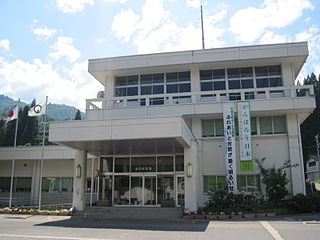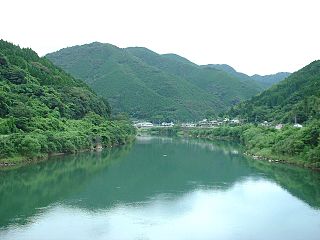
Alberobello is a small town and comune of the Metropolitan City of Bari, Apulia, southern Italy. It has 10,735 inhabitants and is famous for its unique trullo buildings. The trulli of Alberobello have been designated as a UNESCO World Heritage site since 1996.

A dam is a barrier that stops or restricts the flow of surface water or underground streams. Reservoirs created by dams not only suppress floods but also provide water for activities such as irrigation, human consumption, industrial use, aquaculture, and navigability. Hydropower is often used in conjunction with dams to generate electricity. A dam can also be used to collect or store water which can be evenly distributed between locations. Dams generally serve the primary purpose of retaining water, while other structures such as floodgates or levees are used to manage or prevent water flow into specific land regions. The earliest known dam is the Jawa Dam in Jordan, dating to 3,000 BC.

Toyama Prefecture is a prefecture of Japan located in the Chūbu region of Honshu. Toyama Prefecture has a population of 1,044,588 and has a geographic area of 4,247.61 km2. Toyama Prefecture borders Ishikawa Prefecture to the west, Gifu Prefecture to the south, Nagano Prefecture to the east, and Niigata Prefecture to the northeast.

Toyama Airport is an airport located in the city of Toyama, Toyama Prefecture, Japan. The airport services are primarily domestic flights and international flights to China and Taiwan: however, seasonal international charter flights also service Toyama from April to June.

Shirakawa is a village located in Ōno District, Gifu Prefecture, Japan. It is best known for being the site of Shirakawa-gō, a small, traditional village showcasing a building style known as gasshō-zukuri. Together with Gokayama in Nanto, Toyama, it is one of UNESCO's World Heritage Sites.
Kamitaira was a village located in Higashitonami District, Toyama Prefecture, Japan.

Nanto is a city in Toyama Prefecture, Japan. It is in a mountainous area in the south-west corner of the prefecture just north of Gifu Prefecture. It is home to the Gokayama UNESCO World Heritage site. As of 28 February 2018, the city had an estimated population of 51,669 in 17,761 households and a population density of 75.8 persons per km². Its total area is 668.64 square kilometres (258.16 sq mi).

The Kuma River is a river in Kumamoto Prefecture, central Western part of Kyūshū, Japan. It is sometimes referred as Kumagawa River. It is the longest river in Kyushu, with the length of 115 km long and has a drainage area of 1,880 km2 (730 sq mi). The tidal flat of the Kuma River estuary is approximately 1000 hectares.

Gokayama is an area within the city of Nanto in Toyama Prefecture, Japan. It has been inscribed on the UNESCO World Heritage List due to its traditional gasshō-zukuri houses, alongside nearby Shirakawa-gō in Gifu Prefecture. The survival of this traditional architectural style is attributed to the region's secluded location in the upper reaches of the Shōgawa river. This is also the reason that Gokayama's lifestyle and culture remained very traditional for many years after the majority of the country had modernized. Many of the houses surpass 300 years in age.

The Historic Villages of Shirakawa-gō and Gokayama are one of Japan's UNESCO World Heritage Sites. The cultural property consists of three historic mountain villages over an area of 68 hectares in the remote Shogawa river valley, stretching across the border of Gifu and Toyama Prefectures in central Japan. Shirakawa-gō is located in the village of Shirakawa in Gifu Prefecture. The Gokayama area is divided between the former villages of Kamitaira and Taira in Nanto, Toyama Prefecture.

Malampuzha Dam is the second largest dam and reservoirs in Kerala, located near Palakkad, in the state of Kerala in South India, built post independence by the then Madras state. Situated in the scenic hills of the Western Ghats in the background it is a combination of a masonry dam with a length of 1,849 metres and an earthen dam with a length of 220 metres making it the longest dam in the state. The dam is 355 feet high and crosses the Malampuzha River, a tributary of Bharathappuzha, Kerala's second longest river. There is a network of two canal systems that serve the dam's reservoir of 42,090 hectares.
P.A. Works, Inc. is a Japanese animation studio founded on November 10, 2000 in Nanto, Toyama. The company's president and founder Kenji Horikawa once worked for Tatsunoko Production, Production I.G and Bee Train Production, before forming P.A. Works Corporation. The studio changed its name to P.A. Works in 2002. The main office is located in Toyama Prefecture, where drawings and digital photography take place, and production and direction in the office. The company is also involved with video games, as well as collaborating in the past with Production I.G and Bee Train for anime. In January 2008, P.A. Works produced True Tears, their first anime series as the main animation studio involved in the production process. On April 20, 2018, P.A. Works announced a new e-book label named P.A. Books, with the first release being a novel adaptation of their first anime, True Tears.

The Tōkai-Hokuriku Expressway is a national expressway in the Chūbu region on the island of Honshū in Japan. It is managed by Central Nippon Expressway Company. The route is signed E41 under the Ministry of Land, Infrastructure, Transport and Tourism's "2016 Proposal for Realization of Expressway Numbering."

The Shō River has its source in Mount Eboshi in the Shōkawa-chō area of Takayama, Gifu Prefecture, Japan. After flowing for 115 km (71 mi) through the northern part of Gifu Prefecture and the western part of Toyama Prefecture, it empties into Toyama Bay.

The Samanala Dam is a dam primarily used for hydroelectric power generation in Sri Lanka. Commissioned in 1992, the Samanalawewa Project is the third-largest hydroelectric scheme in the country, producing 405 GWh of energy annually. It was built with financial support from Japan and the United Kingdom. It is notable for a large leak on its right bank. Power production continues as planned despite the leakage, and the water from the leak now provides two thirds of the water issued by the reservoir for agriculture in downstream areas.

The Hokuriku dialect is a Japanese dialect group spoken in Hokuriku region, consists of northern Fukui Prefecture, Ishikawa Prefecture, Toyama Prefecture, and Sado Island in Niigata Prefecture. Mainland Niigata dialect is classified into Tōkai-Tōsan dialect and Tōhoku dialect and southern Fukui dialect is classified into Kansai dialect.

The Gōnokawa River is a river that runs through Hiroshima and Shimane prefectures in Japan. It is the largest river in the Chūgoku region. It is also called the Gōgawa River and, in Hiroshima, the Enokawa River.

The Shin-Takasegawa Pumped Storage Station (新高瀬川発電所) uses the Takase River to operate a pumped storage hydroelectric scheme about 12 kilometres (7.5 mi) west of Ōmachi in Nagano Prefecture, Japan. Part of the system is within Chūbu-Sangaku National Park.

















